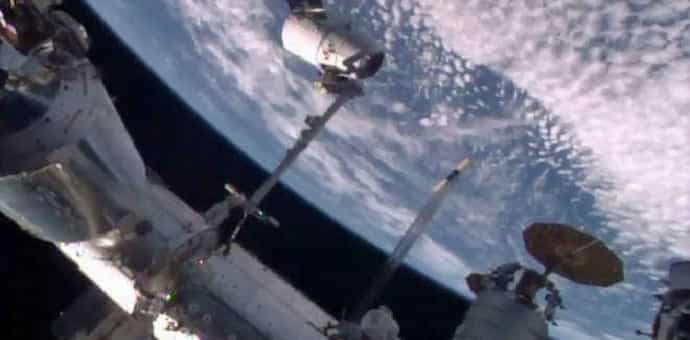SpaceX Dragon Arrives at Space Station to Delivers Inflatable Room Prototype
SpaceX’s Dragon cargo ship arrived at the International Space Station (ISS) on Sunday to deliver its vital freight to the six astronauts living in the station. The space ship carried an experimental inflatable space habitat that might be important for future deep space explorations.
Two days after it dashed towards space from the Cape Canaveral Air Force Station in Florida, the spacecraft reached ISS on Sunday. Thanks to SpaceX’s Falcon 9 rocket.
Xinhua quoted the US space agency NASA as saying that the spacecraft was successfully captured at 7:23 a.m. Eastern Daylight Time (1123 GMT) by European astronaut Tim Peake, using the orbiting lab’s robotic arm, with help from US astronaut Jeff Williams.
“It looks like we caught a Dragon,” said Peake of the European Space Agency.
Since March 26, another US commercial cargo ship called Cygnus has been attached to the station. Two Russian Soyuz crew capsules and two Progress cargo ships are also docked at the moment. As a result, “Dragon’s arrival marks the first time two commercial cargo vehicles have been docked simultaneously at the space station,” NASA said.
“With the arrival of Dragon, the space station ties the record for most vehicles on station at one time — six,” said NASA.
The last time six vehicles were docked to the station was back in the space shuttle era, when Discovery visited in February 2011.
The unmanned Dragon carries more than 3,100 kilograms (7,000 pounds) of freight, including food supplies, laboratory experiments and an inflatable room, known as the Bigelow Expandable Activity Module (BEAM), a $17.8 million project that will test the use of an inflatable space habitat in micro-gravity.
BEAM, now attached to the station, has been sent to test how it stands up to space debris and radiation. It is expected to be filled with air to expand four and a half times its original volume at the end of May after being attached to the ISS.
During its two-year test mission, astronauts will enter the module for a few hours several times a year to retrieve sensor data and evaluate conditions.
Inflatable habitats are designed to take up less room on a rocket, but provide greater volume for living and working in space once expanded, NASA said, noting that this test allows investigators to measure how well the expandable habitat protects itself against solar radiation, space debris and contamination.
The new experiments onboard Dragon will help investigators evaluate the impact of antibodies on muscle degradation, search for insight into the interactions of particle flows at the nanoscale level and use protein crystal growth in microgravity to help in the design of new drugs to fight disease.
The spacecraft was launched last Friday from Cape Canaveral, Florida, atop the California-based company’s own Falcon 9 rocket, which made history by landing the first stage of its Falcon 9 rocket on a drone ship in the Atlantic Ocean for the first time, after four previous attempts at water touchdown ended in failure.
Dragon will remain connected to the ISS until May 11, when it will depart for a parachute-assisted splashdown off the coast of California, bringing almost 3,500 pounds (1,600 kilograms) of science, hardware and spacewalking tools back to Earth for further study.

